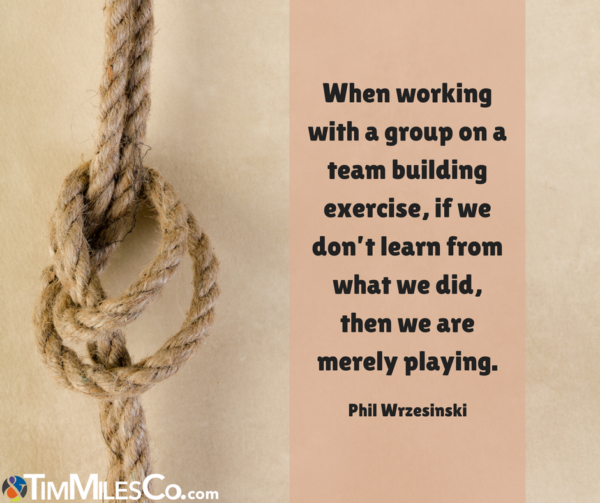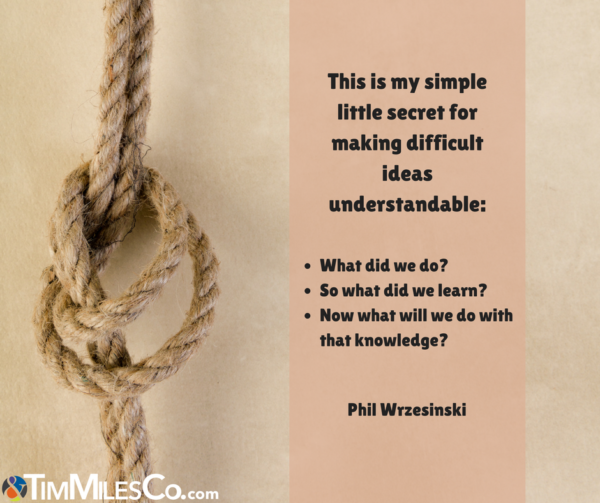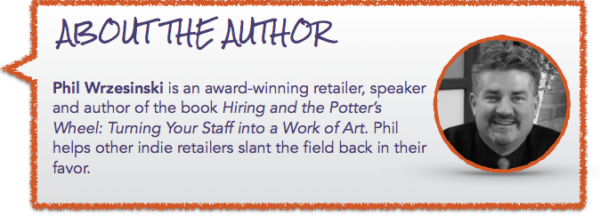(Today’s awesome guest essay comes from Phil Wrzesinski – retailer, writer, dad extraordinaire. It is not often you hear of someone in retail with such a passion for teaching and writing. But Phil is not your average man. Phil has written multiple books and gives you a peek inside his head in a blog called Phil’s Forum that you should definitely check out. Today’s article was originally published on his blog on August, 17, 2015. Take it away, Phil.)
I have been told that I have an uncanny knack for taking difficult ideas & concepts and breaking them down so that they are easy to understand. Others call it a God-given talent.
The true secret is in three simple questions.
I was twenty-three when I learned the power of these three questions. I was working at YMCA Storer Camps teaching Team Building through Wilderness and Experiential Education programs when John Foster and Phil DeLong taught me “What? So What? Now What?” as a way to process learning.
It looks like this…
WHAT?
What happened? What did we do? What worked? What didn’t work? Where did we start? Where did we end?
These questions talk about the CONCRETE. These questions help us identify the task we attempted, the action we took. When working with a group doing a team building exercise, the first step is to make sure we are all on the same page with what actually happened. So we ask the What? questions. We ask them to relive the experience and talk through what they did.
SO WHAT?
So what did we learn? So what can we infer from our results? So what does that show us? So what will we do differently next time?
These questions talk about the ABSTRACT. After we identify what we did, we have to learn from it. We have to extract the lessons. When working with a group on a team building exercise, if we don’t learn from what we did, then we are merely playing. The So What? questions draw out that lesson or idea. The So What? questions give the activity meaning.
(Note: if you don’t establish the What? first, you’ll have a hard time drawing out the So What? lessons. So What? questions can only be asked after the What? has been firmly established.)
NOW WHAT?
Now what will we do with this new understanding? Now what do we do with what we’ve learned? Now what is the next step? Now what will we do when we get back to the office?
These questions talk about the APPLICATION. Now what do we do with what we’ve learned? A good team builder not only helps a group learn the lesson from their activity, but also how to apply that lesson to other parts of their life.
It is one thing to learn about proper communication while crossing a swamp with a string of tire swings. It is something else to learn how to apply straight-forward, no-mincing of words, chain-of-command communications to the office to keep everyone safe and swinging in harmony, too.
(Note: if you don’t establish the So What? lesson first, you’ll have a hard time drawing out the Now What? applications. Now What? questions can only be asked after the So What? lesson has been firmly understood.)
USING IT EVERY SINGLE DAY
Even though I spend more time running a retail toy store and teaching classes to fellow retailers than I do team building, I find I am using “What? So What? Now What?” every single day.
I use it training my staff… What did we do for this training activity? We asked questions, had to listen to the response, and then repeat the response back to the other team member. What were some of the problems? Trying to remember what was said. Why was that a problem? Because we weren’t used to repeating back, only responding. What was in your way? Not listening properly. How did repeating back what they said help? It forced us to listen better and helped us be more accurate. Why would this be important? The better we listen and be accurate with what a customer says, the better we can solve their problem.
I use it interviewing for new employees… Tell me about a time when you received Great Customer Service (concrete). So what made that so special? (abstract). How would you apply that to you working here? (application).
It is especially effective when I teach classes and do workshops. Just a few weeks ago I did a one-hour class on Inventory Management for pet store owners. This class involves a lot more math and fewer jokes than other workshops and classes I teach. The feedback and vibe from the audience during this class is the lowest of any class I offer.
The only real way I can evaluate how things are going is from the questions the participants ask during Q&A. If they are asking “What?” questions then I failed miserably. They didn’t understand the math I want them to do.
If they are asking “So What?” questions then I still failed miserably. They understood the math but don’t get why they need it.
But…
If they are asking “Now What?” questions then I know I got the point across and they just want to apply it to their own situation. At this particular class, all the questions were of application.
I even use this with advertising. If I want to make a factual point (concrete) then I have to explain why it is an important point (abstract) and what to do with that point (application). More importantly, if I make an abstract point, I better back it up with concrete facts if I want people to apply it.
It took me a while to wrap my head around this model of questioning, but once I did, it made facilitating and leading others much easier. Whenever a discussion bogs down, I simply drop back a level of questioning and make sure we have established the previous level before moving on. This gets everyone back onto the same page. This is my simple little secret for making difficult ideas understandable.
- What did we do?
- So what did we learn?
- Now what will we do with that knowledge?
Learn to use it in your life. It will make a difference.
PS It even works with children. I use it with my boys all the time. They get a lot of Aha! moments through these questions.
(Phil, thank you for being awesome. Anyone who wants to read more by Phil should check out his blog here. If you’re interested in submitting a guest essay, we’d love to hear from you. We’re looking for stories about management, marketing, or motivation that would be helpful to people who own or work for family businesses or nonprofit organizations. Contact us with your submission today!)



